Ask Jocelyn
- Details
- Hits: 5288
 Scarsdale resident Jocelyn Greenky-Herz loves to give advice. In fact, in 2004, Simon and Schuster published her first book of advice, The Big Sister's Guide to The World of Work: The Inside Rules that Every Working Girl Should Know (www.BigSistersGuide.com). She has appeared on numerous television and radio shows and is a featured speaker at universities, corporations and women's organizations around the country. She is an AOL Coach (www.coach.com) and a mentor within the Women of Tomorrow Mentor and Scholarship Program (www.Women-of-Tomorrow.com). She lives with her two children, dog, cat and numerous visitors and is a keen observer of life in town. Here are her answers to a few tricky questions about friendship:
Scarsdale resident Jocelyn Greenky-Herz loves to give advice. In fact, in 2004, Simon and Schuster published her first book of advice, The Big Sister's Guide to The World of Work: The Inside Rules that Every Working Girl Should Know (www.BigSistersGuide.com). She has appeared on numerous television and radio shows and is a featured speaker at universities, corporations and women's organizations around the country. She is an AOL Coach (www.coach.com) and a mentor within the Women of Tomorrow Mentor and Scholarship Program (www.Women-of-Tomorrow.com). She lives with her two children, dog, cat and numerous visitors and is a keen observer of life in town. Here are her answers to a few tricky questions about friendship:
Question: My friend is always invading my personal space and stands so close to me that I can’t think straight. I hate it. Help, how do I get her to stop?
Answer: Take a step back to put at least two feet between yourselves. If she moves forward, tell her you have been sick and don’t want her to get your germs. When you leave, do not kiss goodbye or do any air kissing and let her know how great it was to see her. The next time you see her, ensure you keep the two feet rule going and eventually she should get it.
Question: My supposed best friend ratted me out on a new pair of Gucci's to my husband that I wanted to keep secret. Do you think I should ditch her?
Answer:: I hate that. It happened to me as well. I have to say, it’s not the greatest thing on earth that she busted your trust. However, she was probably doing it for a laugh and to get you back for something else. I would have a good heart to heart and let her know to knock off squealing on you because it hurt you. Think twice before you tell her anything of real importance because she did show you her true colors.
Question: I go crazy when I call some of my friends and they jabber on only about their kids. It's just so annoying. What can I do?
Answer: Know what you are in for when you call that person. Get a bag of popcorn, pretend you are at the movies, put a timer on and listen. Once the 9 minutes are up, tell your friend you forgot to do something important and tell her how great it was to catch up and then, hang up. Your friend will think you are an amazing listener - and you have done your duty. Here's the real piece of advice, if you ever plan to share a meal with that person, you will be locked in for hours - so try and only make it a phone call.
Question: I told my close friend a secret that I wish I had kept to myself. What now?
Answer: Remind yourself that whatever you say to another human being - other than to clergy or a parent – may be repeated. Take your friend out to coffee and ask her to please keep it on the DL (down low for those of you who are learning the English language). I am sure she will say of course that she will keep it confidential but we all know that doesn't guarantee squat. Most likely your friend won't repeat a thing knowing how important it is to you. Next time, THINK, THINK, THINK before you repeat something that you consider sensitive.
Question: My friend makes plans with me and is either always late or cancels at the last minute. What can I do?
Answer: Uh, don't make plans with her! GET RID OF HER. Really, what kind of friend is that exactly? Even though she may listen to your trials and tribulations - anyone who is not respectful of your time should go bye-bye from your personal Rolodex. Don't put up with that malarkey and find friends who are considerate.
If you have comments about the questions above, or additional questions for Jocelyn, please post them in the comments section below.
Vacarros Closing in Downtown Scarsdale
- Details
- Hits: 9175
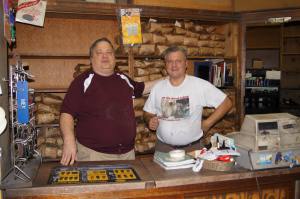 Vacarros Shoe Repair, one of the first businesses to open in downtown Scarsdale, will close at the end of August. Three generations of the Vacarro family kept the people of this town on their well-shod feet since 1929, the year of the stock market crash, and now, as the country faces another economic downturn, the family run shop is about to close its doors. The eight decades of the store traces a history of the country from the time of the arrival of waves of immigrants hoping to make their fortune and care for their families while becoming proud Americans to a time of uncertainty. The fate of the store has the fate of many mom and pop stores, here and throughout the country and reflects changes in buying habits, style, and mores.
Vacarros Shoe Repair, one of the first businesses to open in downtown Scarsdale, will close at the end of August. Three generations of the Vacarro family kept the people of this town on their well-shod feet since 1929, the year of the stock market crash, and now, as the country faces another economic downturn, the family run shop is about to close its doors. The eight decades of the store traces a history of the country from the time of the arrival of waves of immigrants hoping to make their fortune and care for their families while becoming proud Americans to a time of uncertainty. The fate of the store has the fate of many mom and pop stores, here and throughout the country and reflects changes in buying habits, style, and mores.
The shop was founded by Donato Vaccaro, grandfather of the current owner Luke Vacarro. One of the first merchants in downtown Scarsdale, Vacarro signed a lease for the space with Rush Wilson’s grandfather and the Harwood Building remains in the Wilson family today. At that time, the Scarsdale Post Office was in the Harwood Building, occupying the space now held by retailer LF, and a grocer sold premium meats from another store in the building. According to Luke, his overworked grandfather died young in 1950 leaving the store to Luke’s father. Luke’s dad, who was 40 at the time, and the father of 13 children learned on the job. He also worked without rest and died leaving Luke to take over the family business at the tender age of 19. Though Luke dreamed of being a math teacher and basketball coach, he had to drop out of college to run the shop to support his widowed mother and 12 younger brothers and sisters.
Like his father, Luke learned on the job, first sweeping the store, then wrapping the shoes and later moving on to shoe shine, and repair. He was the man at the counter and the face of the Vaccaro family to the community. With the help of his family, including his sister Nikki Reno and his brother Justin, he has run the shop for 41 years, since 1970.
During these years, he pursued his love of coaching basketball, founding an AAU Girl’s Travel Basketball team that still operates today. When Scarsdale High School needed a girl’s basketball coach, parent’s drafted Vacarro, who said he would try it for a year in 1996 and ended up staying on for 15 years. To keep up with work at the shop he would often coach from 6 pm – 9 pm, and return to the shop after practice at night. During his career, he coached star players Hillary Howard of Scarsdale and Katrina Gaither of Mt. Vernon and continues to coach the AAU team today.
In the 1960’s, Vacarro’s sold pet food and supplies in addition to running the shoe repair. They kept three rhesus monkeys in a cage in the large front display window to entertain customers. On one occasion one of the monkeys got out of the cage at night and when the shop opened in the morning the monkey was found sitting behind the register chewing on a piece of leather. Another day, a monkey escaped and was spotted in a tree at the Scarsdale Post Office on Chase Road. The Fire Department needed to bring in a ladder to get him down. Scarsdale alumni often return to town for their reunions and stop in at Vacarros to look for the monkeys.
So why is the shop closing now after 82 years in business? The reasons are numerous:
- Vacarro reports that people now wear more casual shoes and sneakers, trading in leather soles for rubber and plastic soled shoes that are thrown away, rather than repaired.
- Customers used to hold onto their shoes for years, repairing heels and soles and having them shined regularly. Now people are more likely to toss shoes than repair them.
- Workplaces have become more casual and people no longer wear good leather shoes everyday.
- Shoemaking is a vanishing trade and it is difficult to find skilled craftsman to repair leather shoes, bags and belts. Vacarro reports that 75% - 80% of shoe repair shops in the country have closed since the 1980’s.
- At one time, the shop repaired shoes for big stores such as Bonwit Teller, Neiman Marcus and Florsheim. But many of those stores have gone out of business and it no longer makes economic sense for stores to repair damaged merchandise.
So what’s in store for Vacarro? He is looking for a new position and for the first time in his life he will work for someone else. He’ll continue to coach and hopes to open a basketball gym with several other local coaches. Looking back at 43 years in town, he reminisced about his friend David Emmer who ran the Scarsdale Wrapping and Shipping Center, and thought of all the stores that closed before him - such as Arcade Stationers, County Men and Boys and the Scarsdale Pharmacy.
He said, “I’ve been very fortunate and learned a lot from my customers. They were patient, beautiful, kind and generous, and very good to my family.” Most would agree that the Vacarros have been good to the people of Scarsdale. They will be missed.
Davis Park Gets Ready For a Renovation
- Details
- Hits: 5087
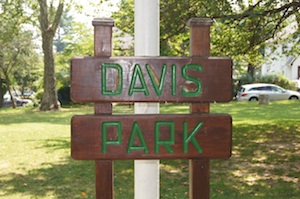 Call it Extreme Makeover: Playground Edition. Ok, so maybe it isn't all that extreme, but Davis Park is getting ready for an upgrade. Davis Park, as some may know, is the park and playground located in the Edgewood neighborhood between Carman Road and Boulevard. Many parents and caregivers like going to this park because it has a lot of shade. I love it since it's close to my house and gives my kids a place to play without requiring me to shell out cash for a swing set.
Call it Extreme Makeover: Playground Edition. Ok, so maybe it isn't all that extreme, but Davis Park is getting ready for an upgrade. Davis Park, as some may know, is the park and playground located in the Edgewood neighborhood between Carman Road and Boulevard. Many parents and caregivers like going to this park because it has a lot of shade. I love it since it's close to my house and gives my kids a place to play without requiring me to shell out cash for a swing set.
According to Suzanne Busby, Superintendent of Parks and Recreation at Scarsdale Village Hall, Davis Park is due for some improvements as it was one of the first playgrounds in town to get new equipment about 20 years ago when national safety guidelines were updated. The equipment has a considerable amount of wear and tear from constant use. The landscaping will not change. No trees will be cut down so the park will stay shady.
Since the park serves families in the community the Davis Park Playground Committee wants to hear from you: Should the playground be geared towards younger kids or should there also be equipment for older ones as well? Are there certain pieces of equipment or playgrounds that your kids have been to that have been simply terrific? Are there things that you think should be eliminated?
The committee is in the idea-gathering phase now and will start meeting with vendors soon.
Resident and head of the Davis Park Playground Committee, Chip Rich explains; “The footprint of the playground is 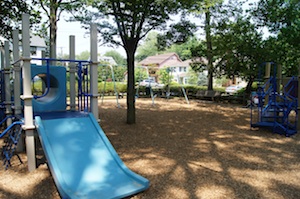 somewhat small and is in close proximity to the surrounding homes, so there are limitations, but we want to make sure everyone has a chance to make their voice heard during this stage of the process, so we can develop and submit a plan to the Village in the fall and get it in the budget for 2012.”
somewhat small and is in close proximity to the surrounding homes, so there are limitations, but we want to make sure everyone has a chance to make their voice heard during this stage of the process, so we can develop and submit a plan to the Village in the fall and get it in the budget for 2012.”
To be sure, a makeover at Davis Park is not a done deal. Busby says while money to renovate the park will be on the 2012 budget, there is no guarantee it will pass. With the tax cap now in effect, unless there is an override of a 60% super-majority vote, there is no guarantee any updates or any capital improvement projects will be included in the budget.
The tax cap debate may have originally centered on the schools, but there is clearly more to it than that. Most residents do not want to see their playgrounds fall into disrepair.
If you would like to share your ideas on how Davis Park should look have your voice heard! Email the playground committee heads Chip Rich at chip.rich@deutschinc.com or Felicia Block at f_liss@hotmail.com by August 10th.
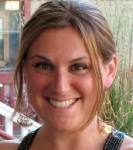 Jen Geller is a freelance journalist who has covered the economy and markets for over a decade at a major financial news outlet. She lives in Scarsdale with her husband and 2 children. Jen has yet to bake a successful batch of cookies.
Jen Geller is a freelance journalist who has covered the economy and markets for over a decade at a major financial news outlet. She lives in Scarsdale with her husband and 2 children. Jen has yet to bake a successful batch of cookies.
Dog Tales: The Making of a Show Dog
- Details
- Hits: 5016
 Patti Friedman, a 20-year resident of Brewster Road, is now the proud owner of a champion show dog. Ari, her Welsh Springer Spaniel, recently became a champ and here is the story of how Patty went from being a dog lover to the owner of a dog who competes in competitive dog shows. Scarsdale10583 asked Patti a few questions and photographed Ari who was very cooperative!
Patti Friedman, a 20-year resident of Brewster Road, is now the proud owner of a champion show dog. Ari, her Welsh Springer Spaniel, recently became a champ and here is the story of how Patty went from being a dog lover to the owner of a dog who competes in competitive dog shows. Scarsdale10583 asked Patti a few questions and photographed Ari who was very cooperative!
Scarsdale10583: When did you first get a dog? When I was about seven years old we bought a house from people who were retiring and couldn't keep their dog. My parents agreed to take the dog, a black poodle named Andre, along with the house. From there, my parents went on to own as many as five dogs at a time. My father became known in the community as the guy to call if you ever needed someone to take a dog. My parents still have a dog they adopted 14 years ago. My father was also in the pet products industry and named one of his business ventures Andre after our first dog,
Scarsdale10583: How did you find yourself with three dogs? Is it difficult to take care of them? We ended up with 3 dogs because our first dog Teddy had some health issues early on. We loved him so much that I got worried he might not be around too long. When he was three and a half we got our next dog, Casey, a female. They were doing fine, but as they were aging, it became clear that we would always want two dogs. We had been talking about a third, but my husband Alan kept saying no. He finally relented while his father was very ill and said he wanted to get a puppy when our son Peter was still home so that Peter could bond with the dog. We have been very lucky that our housekeeper of 15 years is wonderful with the dogs and has taken great care of them. She is retiring and since we both work long hours in the city, we are lucky to have found a replacement for her, but will definitely be doing more ourselves. It is a lot of work; the dogs all eat different things, take different medicine (the older two) and have very different personalities. We need to give attention to all of them.
Scarsdale10583: What kind of dogs do you have and why did you select that breed? We have Welsh Springer Spaniels because  we knew someone who had a dog of this breed. We first looked into getting an English Springer Spaniel but determined there was a potential health risk with that breed, so we went for the Welsh. We chose them because we wanted a mid-sized dog, 40/50 lbs, and good with kids. They are known as “Velcro” dogs because they follow their families around wherever they go.
we knew someone who had a dog of this breed. We first looked into getting an English Springer Spaniel but determined there was a potential health risk with that breed, so we went for the Welsh. We chose them because we wanted a mid-sized dog, 40/50 lbs, and good with kids. They are known as “Velcro” dogs because they follow their families around wherever they go.
Scarsdale10583: How did you become interested in showing the dog? Ari's breeder was in Richmond, Virginia. I told him I wanted a dog that would be able to handle two other dogs. He selected Ari for me. As I was leaving told me Ari would make a good show dog. I gave it some thought and had to make a decision about whether or not to neuter him or see if he would have success in the ring. I decided it would be fun to try to show him and to see what happened. I had him evaluated by a couple of dog handlers (professionals) that told me he met the breed standard and therefore could be shown. I am very hopeful that Ari will meet other physical requirements that are important for breeding, such as good hips, eyes and elbows so that he can be a stud dog. He is such a great dog that we want others to have an opportunity to own one of his offspring.
Scarsdale10583: How did you train the dog to be a show dog? We didn't do much in the way of training other than run him around in circles. I met a handler at one of the shows that shows his breed and had a Welsh Springer Spaniel. She told me what we really needed to do was to let her train him for a week and take him to a show. She did all the work and trained him so he knows exactly what to do with her in the ring. We have been working with her since last August, and he had a win at his first show. We then continued through May when he got the championship. We plan to enter more shows later this summer for his Grand Championship and the opportunity to go further in the rankings.
Scarsdale10583: Why is your dog a good show dog? Temperament? Physical characteristics? In order to be a show dog, the dog needs to meet the breed standard -- which takes into consideration height, physical appearance, proportions, teeth, bite, length of ears, and gait. The dog can't be shy and also has to be happy in the ring. The dog needs to exemplify the breed while they are in the ring. Ari is very friendly to the judges, always has his tail up and wags his tail when the judge comes to examine him. The dog has to be able to take commands and listen to the handler who takes him into the ring.
Scarsdale10583: Do you enjoy taking the dog to shows? Anything you can say about the people? I like going to the shows. Ari typically goes separately as his handler takes him in and out of the ring and grooms him. If any of us go from our family, we "hide" while he is in the ring so he doesn't get distracted. I have met a lot of wonderful people from the Northeast that breed, show and own the breed. They are very knowledgeable about the breed and how to distinguish a good performance in the ring from a poor performance as well as how to pick out the top dogs. Many of these folks are second and third generation "dog people." It has been a very interesting learning experience. There is a great deal of discussion about genetics in the different breeding lines and understanding the competitive process.
Scarsdale10583: Many of our readers probably saw “Best in Show.” Is the film accurate? The film is quite accurate. Many of the dogs look like their owners and the prep that goes on before the shows in the movie is exactly the way it is at all the shows. There are people from all walks of life showing a variety of breeds at most of the shows. Many travel all over the country in their RVs to dog shows every weekend. It takes a lot of hard work to show the dogs at their best in all kinds of weather and in a variety of venues.
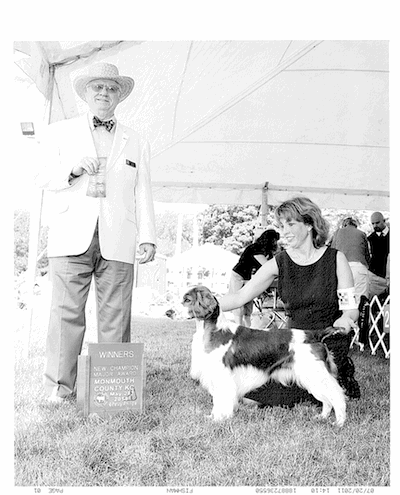 Scarsdale10583: What prize has your dog won? What categories are there and in which one did your dog win? Ari has attained the Champion level. In order to become a champion the dog needs to have 15 points, which includes at least 6 points won at a "major" show-3 points each. A major show is determined by the number of entrants in the breed. There are a variety of designations a dog can achieve in order to get a point or multiple points. There is competition by sex, age (puppy class) and then by other distinctions including open dog, shown and bred by owner and they select those that have at least a championship designation. Once the dog wins the class (which is by sex, e.g., puppy dog age 6-9 months) he goes into the ring and competes with other winners of different classes in order to finally get to the winner for the breed of that show. The winner of the breed then competes against the winners of all the different breeds that are in the class of dogs. Welsh Springers are in the sporting dog category. The winners of each class then compete in best of show.
Scarsdale10583: What prize has your dog won? What categories are there and in which one did your dog win? Ari has attained the Champion level. In order to become a champion the dog needs to have 15 points, which includes at least 6 points won at a "major" show-3 points each. A major show is determined by the number of entrants in the breed. There are a variety of designations a dog can achieve in order to get a point or multiple points. There is competition by sex, age (puppy class) and then by other distinctions including open dog, shown and bred by owner and they select those that have at least a championship designation. Once the dog wins the class (which is by sex, e.g., puppy dog age 6-9 months) he goes into the ring and competes with other winners of different classes in order to finally get to the winner for the breed of that show. The winner of the breed then competes against the winners of all the different breeds that are in the class of dogs. Welsh Springers are in the sporting dog category. The winners of each class then compete in best of show.
Scarsdale10583: What are your plans for the future? We are going to see how Ari does in the next level of competition. He is on the smaller size for the breed and many of the male champions he will now compete against are larger. We will see whether or not there is any opportunity for him to make it to grand champion. Most of the dogs that compete at Westminster are grand champions and the highest-ranking dogs in the breed nationally.
Scarsdale10583: Any funny anecdotes to share? Most breeders give each dog a formal name that typically includes the kennel name. The dogs may have a nickname related to that formal name or a completely different name, which is their everyday name or "call name." For some reason, my breeder didn't give me that name. As a novice, I registered him into the AKC, American Kennel Club, as Ari Friedman. He is listed as Ari Friedman in the AKC records and he is the only dog whose name does not have a kennel related name like his mother, Killagay Tudur Joy O'Meadows, with a call name Joy. Ari and I have gotten a lot of notoriety at the shows because of my mistake. People are nice about it but you know they are sneering. Changing a dog's name with the AKC is not possible. I have tried. As soon as a dog is entered into a competition the name cannot be changed, no exceptions. I am waiting for the announcer at Westminster to call him “Ari Friedman,” though it is highly unlikely he will ever be seen on television. He would have had to make it beyond the breed to the sporting group and then win that group to be in Best of Show. Dog show judging is somewhat political. While I don't know if a Welsh Springer Spaniel has ever been in Best of Show at Westminster, a Welsh Springer has never won Westminster. I would love it to be Ari!
Commuter Concern: How Worried Should You Be About Monday's Metro-North Derailment?
- Details
- Hits: 4619
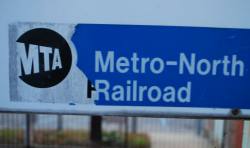 Scarsdale is a big commuter town. If you take the train into Grand Central each day, most likely your biggest concern is getting a seat on the 8:02 express or getting service on your blackberry or laptop on your way to or from the office. The train’s safety is probably not something you worry too much about.
Scarsdale is a big commuter town. If you take the train into Grand Central each day, most likely your biggest concern is getting a seat on the 8:02 express or getting service on your blackberry or laptop on your way to or from the office. The train’s safety is probably not something you worry too much about.
A train derailment on Metro North’s Hudson line right in the middle of the Monday evening rush hour may give you pause: the 6pm train headed for Croton-Harmon derailed about 5 minutes after departing Grand Central. According to the MTA, the train was only going about 10 miles an hour and no one was hurt. However, the train was stuck in the tunnel for an hour and while the lights stayed on, the air conditioning was cut. If you recall, it was over 90 degrees outside on Monday. The passengers were evacuated near an emergency exit around 59th Street (we’ve all seen that sign) and boarded another train home. A fire department spokesperson said four pregnant women on board were taken to local hospitals to be checked out.
While this all sounds fairly miserable, it's not tragic. We’ve all seen news of train derailments that caused massive injuries and fatalities. Metro-North says it works very hard to keep the rails safe.
"Derailments are very rare and in Monday's case it happened at less than 10 mph. We maintain our tracks and will continue to do so. Safety is priority number one and we won't jeopardize the safety of our passengers or our employees," explains Marjorie Anders, an MTA spokesperson, when we spoke this week in light of the Croton-Harmon derailment.
William Henderson, Executive Director of the MTA's Citizen Advisory Committee, says that while he does not know the specifics of this case, weather frequently is a factor when it comes to derailments; in this case, it may have been the heat.
Henderson echos Anders when he says the derailment was quite rare for Metro-North. He adds that in those types of emergencies, though it may sound a bit 'goody-goody' it is really important to follow the crew's instructions. There are procedures in place to keep passengers safe. Yes, it is frustrating when you can see the platform from your window and think you could walk out and not be stuck on the train, but keeping you on the train could be for your own safety.
But could more derailments be ahead for riders?
Henderson says that going forward money is the biggest worry for the MTA and Metro-North. With budgetary cuts, maintenance cycles will likely get stretched. In large part that should be fine, but he doesn't want those cycles stretched beyond what is prudent.
Also in 2012, capital funding runs out and while Metro-North is in good shape, long term that could hurt the trains and the rails.
Something comforting is that the MTA has a zero tolerance policy when it comes to employees using electronic devices while the train is moving so no engineer or conductor can be texting or on the phone while the train is in motion. .
The MTA also points out that Metro-North logged 81.1 million trips last year and had a 97.7% on time record for 2010.
So, even if everything is safe and sound on the rails now, you may want to pack a bottle of water and a pair of comfortable shoes as you head into town. Jen Geller is a freelance journalist who has covered the economy and markets for over a decade at a major financial news outlet. She lives in Scarsdale with her husband and 2 children. Jen has yet to bake a successful batch of cookies.
Jen Geller is a freelance journalist who has covered the economy and markets for over a decade at a major financial news outlet. She lives in Scarsdale with her husband and 2 children. Jen has yet to bake a successful batch of cookies.










